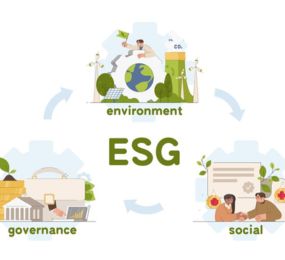Not a long time ago, the environmental activists and niche markets were the only ones who were using this term ("sustainability"). Fast forward to the present, and the financial triangle created by the crypto community is a battleground for innovation, resilience and business sharpness. Among the emergent narratives of this transformation, one theme consistently arises: the inclusion of environmental, social, and governance (ESG) factors into financial reporting does not only refer to a trendy thing but rather it is a radical shift that alters how businesses are run and valued.
The Statistics Speak Volumes
One simply cannot belittle the fact that more than 85 % of big companies of S&P 500 published sustainability reports in the last year alone, increasing dramatically from the figure of 20% just a decade ago, as reported by Governance & Accountability Institute.
-
The rapid uptake of ESG-focused investments has contributed to investable assets soaring to over 30 trillion Dollars worldwide representing a 68% increase in the last four years only (US SIF).
-
The research of Harvard Business Review notes that companies with a decent ESG rating have access to lower interest rates on loans and an excellent increase in market value.
-
In the words of investors themselves, an overwhelming 88% of them, it is also quite evident that non-financial returns carry a lot of weight in their investment decisions (PwC).
-
When firm leaders embrace and reflect diversity in the leadership team, they will become 21% more successful than others that only see benefits of profitability (McKinsey).
The numbers we see, however, have envisioned the mainstream appearance of ESG linking to financial reporting as a vital indicator of firms' future success and competitive advantage.
Incorporating ESG Metrics: FAQs
Q: What motivates firms to reflect ESG characteristics into accounting statements?
A: Besides ethical considerations, the ESG metrics allow for a broad outlook of a company's operational efficiency, risk management and future stability, the latter becoming critical aspects branded as material by investors.
Q: What exact problems could businesses meet, while using ESG as a measuring tool?
A: While one is struggling to determine what metrics and data to use, as well as handling the complexities of the global regulatory environment and global standards, are other challenges.
Q: How can enterprises carry out a good ESG performance measurement and follow the legal requirements?
A: Collaboration with seasoned providers is the number one factor. Detailed reporting, advanced data analytics, regulatory maintenance, and stakeholder engagement tactics are integral to successful ESG reporting.
Pioneering ESG Excellence
Leadvent prides itself as the leader in equipping organizations with the tools to skillfully traverse the murky waters of ESG reporting. Our ESG services package does not only make your company's transition towards sustainability a quick one but also ensures that you become an industry leader by setting asset quality benchmarks in your ESG reporting.
Customized Reporting: This can be achieved by developing unique ESG metrics that are aligned with your industry standards and promoting the use of those guidelines.
-
Data Aggregation and Analysis: Fostering transparency and showing ESG achievements in holistic data representation and practical takeaways.
-
Regulatory Compliance: You may be ahead of the game because we will keep you informed about the latest regulatory standards, as well as global compliance issues.
-
Stakeholder Engagement: Thus, devising strategies to demonstrate your ESG efforts transparently as well as comprehensively.
-
Technology Integration: Utilizing contemporary solutions for organic data orchestration and retroactive reportage.
-
Training and Support: Arming your staff with knowledge and tools to champion the integration of ESG metrics.
Case Studies: In Practice ESG Integration.
Tech Leader X has driven its ESG metrics in its financial portfolio upwards by 25% shares in two years, enhancing shareholder values. Their commitment to environment sustainability and governance overhaul had made a powerful impact among the investor community that in turn built the principle of trust and transparency.
Through retailer Y, it was shown how ESG principles could align with business operations and achieve a 15% decrease in carbon emissions by their third year. The program wasn't just kind to the environment but also built a customer and investor base that was enthusiasm-driven and eco-minded.
Bank Z, proved the financial sense of the integration of the ESG criteria in lending giving 20% reduced non-performing loans.
The steps taken to mitigate environmental and social risks have led to a stronger risk management framework which finally brought down their cost.
The significance of sustainable rating metrics in financial reporting is beyond any doubt in that they inform the market of a company’s level of sustainability. Leadvent now allows for the incorporation of third-party sustainability metrics, which goes even further in providing hassle-free integration of metrics that keeps your business ahead of the curve as prepared for the future.
















